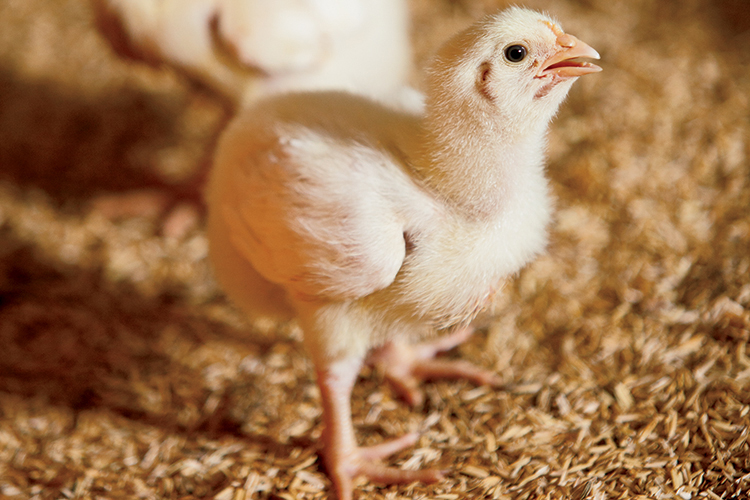Home > Alabama > Alabama Crops & Livestock > Strutting Their Stuff: Alabama Takes Pride in Poultry
Strutting Their Stuff: Alabama Takes Pride in Poultry

With 19 poultry processing plants producing 21 million chickens per week, Alabama ranks second in total production in the U.S., and according to a recent study by the Alabama Cooperative Extension System, the state’s poultry industry has a $15.1 billion impact on the state’s economy – making up 65 percent of agricultural sales and employing 86,000 workers.
Ray Hilburn, associate director at the Alabama Poultry and Egg Association, says the state’s poultry industry continues to expand due to the increased demand for chicken and poultry products.
“Chicken and chicken products can be economically obtained and be of nutritional value for all three meals of the day,” Hilburn says. “The success of the poultry industry can be attributed to the advancement of genetics, technology, and the dedication of its employees and producers. The industry continues to be an asset to the lending agencies that are involved in the financial aspect of the industry and producer investments.”
Guy Hall, poultry division director at Alabama Farmers Federation, says Alabama’s poultry success is thanks to technological advancements that keep the industry one step ahead.
“Alabama’s poultry industry is successful because everyone works together for the betterment of the industry and understands the importance of it to the state’s economy,” he says. “Farmers are willing to invest in poultry housing, land and equipment to take care of their chickens. Poultry companies are willing to invest in infrastructure, such as processing hatcheries and feed mills.”
Keystone Foods, a global food services company with its USA Proteins headquarters in Huntsville, illustrates such commitment with a strong history of innovation from food cryogenics to the introduction of the chicken nugget. By using real-time data, Keystone has stayed competitive by delivering high-quality protein solutions locally, nationally and abroad.
Alabama also has forward-thinking universities and state agencies providing education to farmers on everything from environmental stewardship to bird health.
Ken Macklin, Auburn University Extension specialist and professor, has seen a reduction in bacterial and parasitic infections thanks to improved ventilation within poultry houses. Specifically, attic vents help keep litter dry. And as a result, respiratory-type diseases have also decreased.
“From the farmers’ standpoint, technology improves their bottom line because you get a more uniform bird that grows faster under less environmental stress,” he says. “Birds are happy and can grow without expending extra energy.”
Further, research on optimizing nutrition and preventing disease is revolutionizing the industry. Growing in popularity, antibiotic- free programs, which rely on non-antibiotic therapeutics like probiotics, encourage birds to fight off sub-clinical infections and improve their immune systems![Alabama chicken industry [INFOGRAPHIC]](https://eadn-wc01-4177395.nxedge.io/wp-content/uploads/2020/05/Screen-Shot-2016-03-02-at-9.37.18-AM.jpg)
Poultry House Benefits
Seasoned poultry farmers can attest to the sweeping improvements in poultry houses, especially compared to two decades ago when growers practically lived in the houses.
Today, advanced computerized systems control the entire environment of the house, from automated feed and water to temperature, ensuring optimal comfort. Another important safeguard is the computer’s ability to notify farmers by phone if the temperature, water or power levels fall outside operating parameters.
Additionally, there have been significant improvements in brooders – heaters – which now use infrared heating to warm the ground instead of the air. This switch also impacts output costs, like natural gas and propane.
As for lighting, incandescent bulbs are no longer the norm, says Heath Wesley, Alabama Extension agent and second-generation poultry farmer.
“My poultry houses have LED light bulbs and light dimmers to help with energy efficiency,” he says.
Wesley installed high-tech poultry houses with all of the mentioned innovations. He also uses data management tools that compare past activities, reducing guesswork for any adjustments. Raising almost 1 million birds annually, Wesley finds the technolgy helps optimize weight gains, feed conversion and livability, thus improving performance.
Hall says, “It’s critical to have Alabama farmers willing to use these new technologies on their farms. That’s what makes them competitive and efficient at producing a high-quality, healthy protein source for consumers.”
Overall, it’s an industry that gives Alabama something to crow about.



